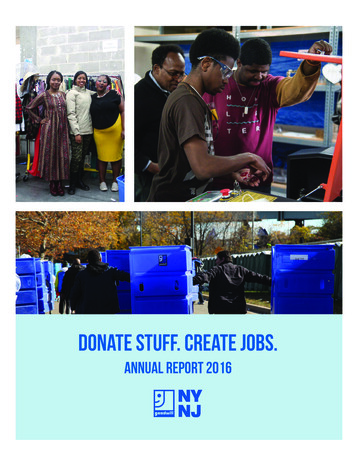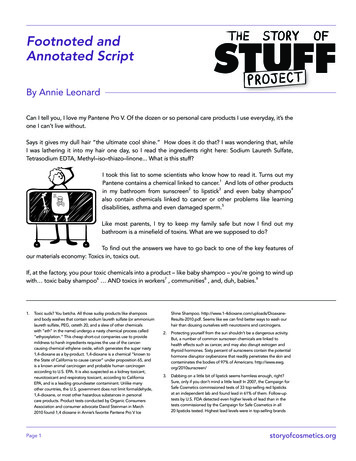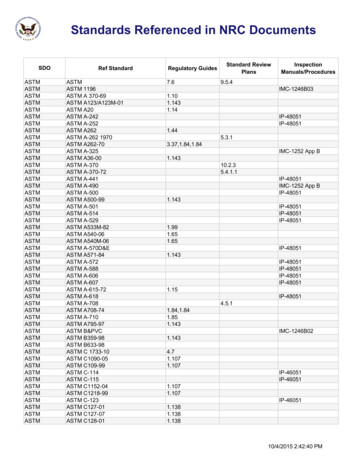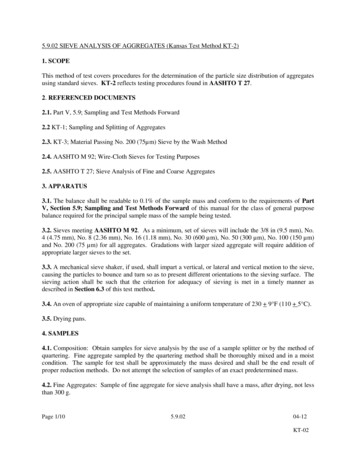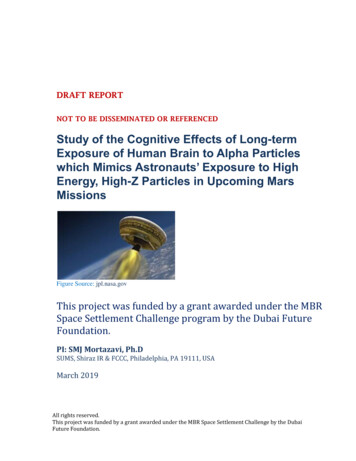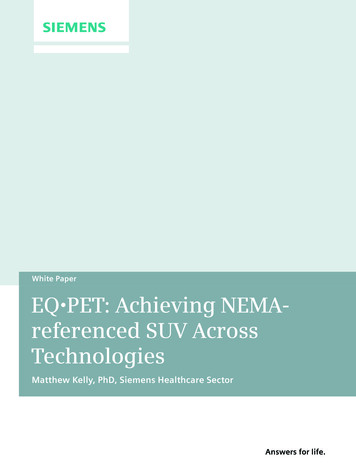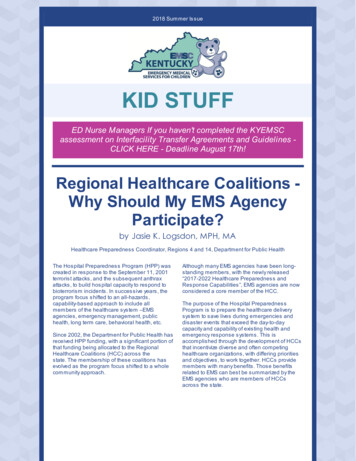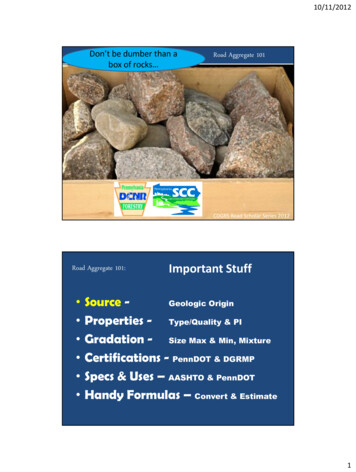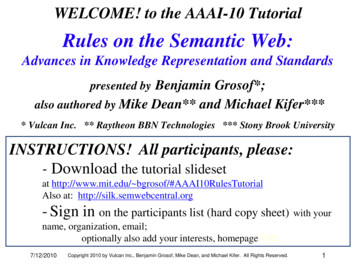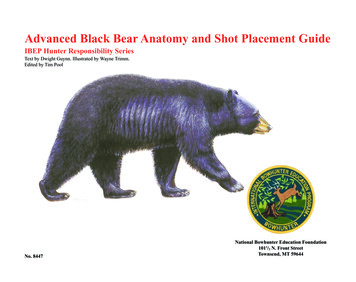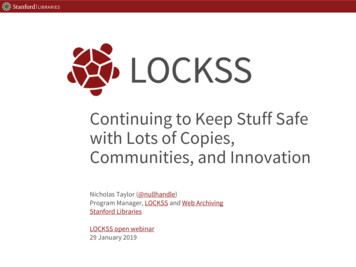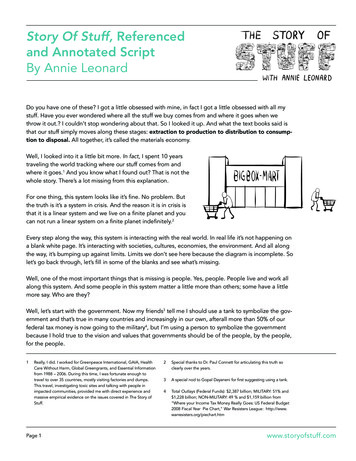
Transcription
Story Of Stuff, Referencedand Annotated ScriptBy Annie LeonardDo you have one of these? I got a little obsessed with mine, in fact I got a little obsessed with all mystuff. Have you ever wondered where all the stuff we buy comes from and where it goes when wethrow it out.? I couldn’t stop wondering about that. So I looked it up. And what the text books said isthat our stuff simply moves along these stages: extraction to production to distribution to consumption to disposal. All together, it’s called the materials economy.Well, I looked into it a little bit more. In fact, I spent 10 yearstraveling the world tracking where our stuff comes from andwhere it goes.1 And you know what I found out? That is not thewhole story. There’s a lot missing from this explanation.For one thing, this system looks like it’s fine. No problem. Butthe truth is it’s a system in crisis. And the reason it is in crisis isthat it is a linear system and we live on a finite planet and youcan not run a linear system on a finite planet indefinitely.2Every step along the way, this system is interacting with the real world. In real life it’s not happening ona blank white page. It’s interacting with societies, cultures, economies, the environment. And all alongthe way, it’s bumping up against limits. Limits we don’t see here because the diagram is incomplete. Solet’s go back through, let’s fill in some of the blanks and see what’s missing.Well, one of the most important things that is missing is people. Yes, people. People live and work allalong this system. And some people in this system matter a little more than others; some have a littlemore say. Who are they?Well, let’s start with the government. Now my friends3 tell me I should use a tank to symbolize the government and that’s true in many countries and increasingly in our own, afterall more than 50% of ourfederal tax money is now going to the military4, but I’m using a person to symbolize the governmentbecause I hold true to the vision and values that governments should be of the people, by the people,for the people.1Really, I did. I worked for Greenpeace International, GAIA, HealthCare Without Harm, Global Greengrants, and Essential Informationfrom 1988 – 2006. During this time, I was fortunate enough totravel to over 35 countries, mostly visiting factories and dumps.This travel, investigating toxic sites and talking with people inimpacted communities, provided me with direct experience andmassive empirical evidence on the issues covered in The Story ofStuff.Page 12Special thanks to Dr. Paul Connett for articulating this truth soclearly over the years.3A special nod to Gopal Dayaneni for first suggesting using a tank.4Total Outlays (Federal Funds): 2,387 billion; MILITARY: 51% and 1,228 billion; NON-MILITARY: 49 % and 1,159 billion from“Where your Income Tax Money Really Goes: US Federal Budget2008 Fiscal Year Pie Chart,” War Resisters League: fstuff.com
It’s the government’s job is to watch out for us, to take care of us. That’s their job.5Then along came the corporation. Now, the reason the corporation looks bigger than the governmentis that the corporation is bigger than the government. Of the 100 largest economies on earth now, 51are corporations.6 As the corporations have grown in size and power, we’ve seen a little change in thegovernment where they’re a little more concerned in making sure everything is working out for thoseguys than for us.7OK, so let’s see what else is missing from this pictureExtractionWe’ll start with extraction which is a fancy word for natural resource exploitation which is a fancy wordfor trashing the planet. What this looks like is we chop down trees, we blow up mountains to get themetals inside, we use up all the water and we wipe out the animals.So here we are running up against our first limit. We’re running out of resources.8We are using too much stuff. Now I know this can be hard to hear, but it’s the truth and we’ve gottadeal with it. In the past three decades alone, one-third of the planet’s natural resources base have beenconsumed.9 Gone.5When the U.S. government was created, its job descriptionincluded to “promote the general welfare of ourselves and ourposterity.” and to secure “our rights to life, liberty and the pursuitof happiness. See the Preamble of the U.S. Constitution: Wethe people of the United States, in order to form a more perfectunion, establish justice, insure domestic tranquility, provide forthe common defense, promote the general welfare, and securethe blessings of liberty to ourselves and our posterity, do ordainand establish this Constitution for the United States of America.See also the U.S. Declaration of Independence: “We hold thesetruths to be self-evident, that all men are created equal, that theyare endowed by their Creator with certain unalienable Rights, thatamong these are Life, Liberty and the pursuit of Happiness. —That to secure these rights, Governments are instituted amongMen, deriving their just powers from the consent of the governed.”6“Of the world’s 100 largest economic entities, 51 are nowcorporations and 49 are countries.” Source: “Top 200: The Rise ofCorporate Global Power” by Sarah Anderson and John Cavanaghof the Institute for Policy Studies, Washington, D.C. December2000. Available at: http://www.ips-dc.org/reports/top200text.htm7Much has been written about the increasing corporate influenceover the government in the U.S. and internationally. For a generaloverview, see When Corporations Rule the World, by David Korten(1995) and other titles in the Recommended Reading list onstoryofstuff.com. Specifically related to industry influence on occupational and environmental health: “Traditional covert influence ofindustry on occupational and environmental health (OEH) policiesPage 2has turned brazenly overt in the last several years. More than everbefore the OEH community is witnessing the perverse influenceand increasing control by industry interests. Government has failedto support independent, public health-oriented practitioners andtheir organizations, instead joining many corporate endeavors todiscourage efforts to protect the health of workers and the community. Scientists and clinicians must unite scientifically, politically,and practically for the betterment of public health and commongood. Working together is the only way public health professionals can withstand the power and pressure of industry. Until publichealth is removed from politics and the influence of corporatemoney, real progress will be difficult to achieve and past achievements will be lost.” in “Industry Influence on Occupational andEnvironmental Public Health.” By James Huff, PhD, in InternationalJournal of Occupational and Environmental Health, VOL 13/NO 1, JAN/MAR 2007 www.ijoeh.com. Also see: “CorporateJunk Science: Corporate Influence at International ScienceOrganizations” by Barry Castleman, R Leman in the MultinationalMonitor, January/February 1998, Vol. 19, No 1& 2.8“In 2003, humanity’s Footprint exceeded the Earth’s biologicalcapacity by over 25 percent.” From Global Footprint Network,http://www.footprintnetwork.org/gfn sub.php?content nationalfootprints9Paul Hawken, Amory Lovins and L. Hunter Lovins, NaturalCapitalism, Little Brown and Company, (1999). Excerpted frompage 4: “In the past three decades, one-third of the planet’sresources, its ‘natural wealth,’ has been consumed.”www.storyofstuff.com
We are cutting and mining and hauling and trashing the place so fast that we’re undermining theplanet’s very ability for people to live here.10Where I live, in the United States, we have less than 4% of our original forests left.11 Forty percent ofwaterways have become undrinkable.12 And our problem is not just that we’re using too much stuff,but we’re using more than our share.We [The U.S.] has 5% of the world’s population but we’re consuming 30% of the world’s resources13and creating 30% of the world’s waste.14If everybody consumed at U.S. rates, we would need 3 to 5 planets.15 And you know what? We’ve onlygot one.So, my country’s response to this limitation is simply to go take someone else’s! This is the Third World,which—some would say—is another word for our stuff that somehow got on someone else’s land.16 Sowhat does that look like?The same thing: trashing the place. 75% of global fisheries now are fished at or beyond capacity.1710 Hawken et all, Natural Capitalism, page 4: “There is no longer anyserious scientific dispute that the decline in every living systemin the world is reaching such levels that an increasing numberof them are starting to lose, often at a pace accelerated by theinteractions of their decline, their assured ability to sustain thecontinuity of the life process. We have reached an extraordinarythreshold.” See also United Nations Environment Programme’sGlobal Environmental Outlook 4 (GEO-4) report, released October2007, available at: http://www.unep.org/geo/geo4/media/11 Lester Brown, Michael Renner, Christopher Flavin, Vital Signs 1998,Worldwatch Institute, Washington, D.C. “Ninety five to ninetyeight percent of forests in the continental United States have beenlogged at least once since settlement by Europeans.” Also, see:“Can’t See the Forest,” by Josh Sevin, in GRIST, 1 March 2000. “1to 2 percent of original forests in the U.S. remain undisturbed.”12 American Rivers, Americas Most Endangered Rivers of 1998Report, Excerpt: “Today, 40 percent of our nation’s rivers areunfishable, unswimmable, or undrinkable” Available at: name AMR content e2a713 This figure is citied in many places. For example: John L Seitz:Global Issues: An Introduction, (2001).14 “The U.S. produced approximately 33% of the world’s waste with4.6% of the world’s population” (Miller 1998) quoted in GlobalEnvironmental Issues by Frances Harris (2004).Page 315 Mathis Wackernagel and William Rees, Our Ecological Footprint:Reducing Human Impact on the Earth (1996) and “USA is thecountry with the largest per capita footprint in the world - afootprint of 9.57 hectares. If everyone on the planet was to livelike an average American, we would need 5 planets, or our currentplanet’s biocapacity could only support about 1.2 billion people”from Much Ado About Nothing, October 11, 2006,retreived11/09/07: http://www.buynothing.biz/blog/index.php?itemid 1316 “The third world is that part of the world which became the coloniesin the last colonialization. It wasn’t an impoverished world then,in fact the reason it was colonialized is because it had the wealth.Columbus set sail to get control of the spice trade from India, it’sjust that he landed on the wrong continent and named the originalinhabitants of this land Indian thinking he had arrived in India.Latin America was colonialized because of the gold it had. Noneof these countries were impoverished. Today they are called thepoorer part of the world because the wealth has been drainedout.” Vandana Shiva, interviewed in In Motion Magazine, 14August 1998.17 75% of the major marine fish stocks are either depleted, overexploited or being fished at their biological limit.” Source: WorldSummit on Sustainable Development 2002, “A Framework forAction on Biodiversity & Ecosystem Management”, www.johannesburgsummit.org/html/documents/wehab papers.html, cited onThe Global Education Project webpage: d-from-the-oceans.phpwww.storyofstuff.com
80% of the planet’s original forests are gone.18 In the Amazon alone, we’re losing 2000 trees a minute. That is seven football fields a minute.19And what about the people who live here? Well. According to these guys, they don’t own theseresources even if they’ve been living there for generations, they don’t own the means of productionand they’re not buying a lot of stuff. And in this system, if you don’t own or buy a lot of stuff, you don’thave value.20ProductionSo, next, the materials move to “production“ and what happens there is we use energy to mix toxicchemicals in with the natural resources to make toxic contaminated products.There are over 100,000 synthetic chemicals in commerce today.21 Only a handful of these have evenbeen tested for human health impacts and NONE of them have been tested for synergistic healthimpacts, that means when they interact with all the other chemicals we’re exposed to every day.22So, we don’t know the full impact of these toxics on our health and environment of all these toxicchemicals. But we do know one thing: Toxics in, Toxics Out. As long as we keep putting toxics into ourproduction system, we are going to keep getting toxics in the stuff that we bring into our homes, ourworkplaces, and schools. And, duh, our bodies.2318 See: http://www.nrdc.org/land/forests/fforestf.asp and ran.org andamazonwatch.org19 See: “ Welcome to my jungle before it’s gone - Rainforests Statistical Data Included” by Karen de Seve, available at: http://findarticles.com/p/articles/mi m1590/is 11 58/ai 84307435; andhttp://www.solcomhouse.com/rainforest.htm; and id 21420 See Reality. I realize this sentence sounds harsh. I came to thisconclusion after spending over 10 years traveling in Asia, Africaand Latin America, as well as places within the United States,to meet with communities negatively impacted by destructiveresource extractive, production, disposal and “development”projects. I saw with my own eyes how, time and time again, wholecommunities are displaced, ignored, shut out of decision makingprocesses. I spent time with communities in India displaced forindustrial complexes, special economic zones, dams, coal firedenergy plants and high end tourist facilities. Over and over, I sawcommunity members struggling to be heard in a democratic process, struggling to keep their families, community, health and localeconomies intact. The consistent characteristic of these impac
and Annotated Script By Annie Leonard 1 Really, I did. I worked for Greenpeace International, GAIA, Health Care Without Harm, Global Greengrants, and Essential Information from 1988 – 2006. During this time, I was fortunate enough to travel to over 35 countries, mostly visiting factories and dumps. This travel, investigating toxic sites and talking with people in impacted communities .
